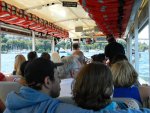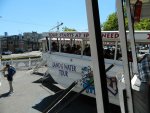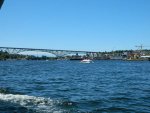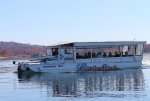To all who have said this is not a true military vehicle you are wrong.
I just thought I would throw my two cents in on this, as I built the dukw's in Branson,Mo that were flatbeded all across the country including the some of the ones in the cities affected by these accidents. This is where I broke my teeth in to restoring old military equipment after the service. I dont know if my dukw's were one of the ones involved in the accidents, but I truly feel sorry for the loss of life. I'll give you guys the inside scoop from a dukw builders point of view. To note, my service ended with the ride the ducks corporation before the accidents due to a disagreement with ownership over vehicle capacity.
There are three types of dukws in service with this company. First, there are the original dukws. Second, there are stretch dukws. Finally, there are new build "ducks".
The original dukws are military ducks that are stripped, blasted, painted with a marine epoxy, then mechanicals are installed by the driveline shop, then were delivered to me or another dukw finisher. My job was to take a painted roller dukw and completely rebuild it. I was responsible for fitting the through hulls, sealing the prop shaft, installing the bilge pump system, in house crafting a new harness for the entire vehicle, installing the comms/music system, and completing the in house coast guard inspection. The inspector would check my work before I installed the seats, curtains, and decking. After that inspection, I would finish the vehicle, deck it, put all seats and life vests in it and the inspector would then come and perform the actual inspection during operation. Any problems were corrected and the vehicle was shipped to its final destination. These dukws were phased out due to limited passenger capacity.
Stretch ducks followed the same build procedure with the addition that the vehicle was cut completely in half, and a hull section was added from a donor dukw or made in house if a donor was unavailable.
New production "ducks" were made in Baltimore, and I can't comment on them as I was not involved.
Some things about dukw production that may interest you all:
Once the engine and axles were installed, a single man finished the entire vehicle from start to finish.
Wiring harnesses, seats, dashboards, powerplants, and any other part the dukw needed were made in house.
During my service with the company, stretch dukws were the mainstay of the fleet.
I hope I have been able to shed some light on some of the behind the scenes work that went into making these vehicles. I can assure you, every time I rolled a dukw out of my bay, it was in pristine condition and functionally flawless. I knew the vehicle I built with my hands would carry thousands of people during its life and I put the utmost attention to detail as the smallest flaw could endanger its passengers. I can say that the other shops that ran the rides were responsible for the daily maintenance of these very old steel vehicles in a salt water environment. In Branson we had fresh water, and it was much easier on the hulls. I know they played **** keeping front axles in these rigs, even at our shop. It is and was my opinion that the prop through hull and the axles were the weakest link. The combined effects of salt water, young men doing maintenance pressured by rapid turnaround, and steer axles bearing too much weight on new and stretch dukws leads to a dangerous situation that hopefully will be rectified before it costs more people their lives.












